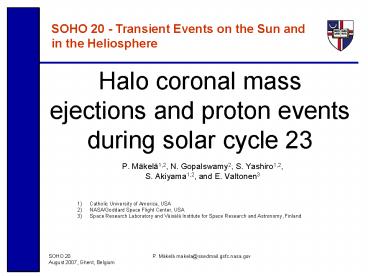SOHO 20 - PowerPoint PPT Presentation
1 / 24
Title:
SOHO 20
Description:
Halo coronal mass ejections and proton events during ... SOHO/ERNE proton intensities. 1.8 - 80 MeV in six energy channels. Storm Sudden Commencement (SSC) ... – PowerPoint PPT presentation
Number of Views:32
Avg rating:3.0/5.0
Title: SOHO 20
1
Halo coronal mass ejections and proton events
during solar cycle 23
SOHO 20 - Transient Events on the Sun and in the
Heliosphere
- P. Mäkelä1,2, N. Gopalswamy2, S. Yashiro1,2,
- S. Akiyama1,2, and E. Valtonen3
- Catholic University of America, USA
- NASA/Goddard Space Flight Center, USA
- Space Research Laboratory and Väisälä Institute
for Space Research and Astronomy, Finland
2
Earth-directed CMEs
- 10 of CMEs hit the Earth
(e.g., Webb and Howard 1994) - 50 of frontside CMEs with widths gt140
encounter the Earth (Cane et al., 2000) - 71 of frontside full halo CMEs are
geoeffective (GE) (Gopalswamy et al., 2007) - Dst-index
- Weak storm -30 nT lt Dst -50 nT
- Moderate storm -50 nT lt Dst lt -100 nT
- Severe storm Dst -100 nT
- CMEs causing strong storms originate more likely
from the western hemisphere (Zhang et al., 2003)
3
Halo CMEs are inherently fast
(Gopalswamy et al. 2007 JGR)
Limb halos are 66 faster than disk halos ?
projection effects
4
Correlations
- CME speed and Solar Energetic Particle (SEP)
intensity correlate (e.g., Kahler,1978
Reames, 1999) - Scatter still large (Kahler, 2001)
- CME speed and geoeffectiveness correlate (e.g.,
Srivastava et al., 2002) - Halo CME rate and SEP event rate correlate (e.g.,
Valtonen, 2006)
5
Data
- Gopalswamy et al. 2007
- LASCO list of full halo CMEs in 1996-2005
(total of 378), flare location and Dst index
(World Data Center in Kyoto) - SOHO/ERNE proton intensities
- 1.8 - 80 MeV in six energy channels
- Storm Sudden Commencement (SSC)
- Solar Geophysical Data
- Shock times
- SOHO/Proton Monitor (http//umtof.umd.edu/pm)
- ACE/SWEPAM and MAG (http//www.bartol.udel.edu/ch
uck/ace/ACElists/obs_list.html)
6
(No Transcript)
7
SEPeffectiveness
- 180 (51) of analysed 354 halo CMEs had
observable proton event. - 135 proton events associated with a frontside
halo CME 63 of all frontside halo CMEs. - 45 proton events associated with a backside CME
32 of all backside halo CMEs (20 behind limb
CMEs).
8
Source location, geoeffectiveness and
SEPeffectiveness
Average longitude Moderate E09 Severe W06
Average longitude Moderate E02 Severe W11
- 40 (67) moderately and 55 (63) strongly GE
frontside CMEs associated with a proton event.
9
SEP Storm Sources
Gopalswamy et al. 2005
SEP source
Storm source
10
- SEPs
- Moderate1217 km/s
- Severe 1284 km/s
- No SEPs
- Moderate 823 km/s
- Severe 757 km/s
11
SEPs with Energetic Storm Particle (ESP) event
with shock/SSC
12
ESP
13
Sources without ESP
but possibly with shock/SSC
14
Peak intensities
Moderate
Severe
2.7-5.1 MeV
12.7-22.1 MeV
15
Longitudinal dependence
Moderate
Severe
2.7-5.1 MeV
12.7-22.1 MeV
16
Speed dependence
Moderate
Severe
C0.62
C0.46
2.7-5.1 MeV
C0.66
C0.14
12.7-22.1 MeV
17
Conclusions
- Conducted a statistical study of 354 halo CMEs
- 51 of geoeffective CMEs associated with a
proton event. - 63 of all frontside halo CMEs associated with
a proton event - 32 of all backside halo CMEs associated with
a proton event - Proton events by strongly GE CMEs are more likely
intense and originate from the western hemisphere
than proton events by moderately GE CMEs - Strongly GE CMEs with a SEP and ESP event
originate west from solar central meridian,
moderately GE CMEs with a SEP and ESP event east
from the central meridian.
18
THE END
19
(No Transcript)
20
Forecasting
- 47-65 keV ion enhancements
- Together with halo CME observations improve
prediction of geoeffectiveness (Smith et al.,
2004) - 1-110 MeV protons
- Improves frontside/backside CME separation.
Travel time proxy correlates with storm strenght. - Specific SEP signatures ambigious
reduced prediction efficiency. (Valtonen et al.,
2005) - E 10 MeV SEP enhancements
- Better than speed as an indicator of
geoeffectiveness (Gleisner 2006).
21
SEP-associated CMEs
Gopalswamy et al. 2005
22
Background
- Gradual Solar Energetic Particle (SEP) event
- CME associated shock accelerates particles
(Reames 1999) - Time profiles highly variable
- Geomagnetic storm
- Interplanetary magnetic field southward for an
extended period of time - Depression in Dst-index
- Weak storm -30 nT lt Dst -50 nT
- Moderate storm -50 nT lt Dst lt -100 nT
- Severe storm Dst -100 nT
(Gopalswamy et al., 2007)
23
Causes of scatter
- Projection effects on speed
(e.g., Burkepile et al., 2004) - Fast/slow SW (Kahler 2004, not observed)
- CME width (Kahler et al., 1984, Gopalswamy et
al., 2004) - CME acceleration (e.g., Kocharov et al. 2001)
- Preceding CMEs (Gopalswamy et al. 2003)
- Preceding SEP events (Kahler 2001).
24
References
- Cane et al. (2000), Geophys. Res. Lett., 27(21),
3591, 10.1029/2000GL000111. - Gopalswamy et al. (2004), J. Geophys. Res.,
109(A12), A12105, 10.1029/2004JA010602. - Gopalswamy et al. (2007), J. Geophys. Res., 112,
A06112, doi10.1029/2006JA012149. - Kahler et al. (1978), Sol. Phys., 57, 429.
- Srivastava et al. (2002), Geophys. Res. Lett.,
29(9), 1287, 10.1029/2001GL013597. - Valtonen (2006), Geophysical Monograph Series
165, Gopalswamy, N., Mewaldt, R., and Torsti, J.
(Eds.), AGU, Washington, DC, 21-32. - Zhang et al. (2003), Astrophys. J., 582, 520.































